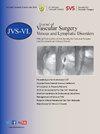动静脉瘘血液透析患者上腔静脉和臂-脑静脉闭塞支架植入术的长期疗效。
IF 2.8
2区 医学
Q2 PERIPHERAL VASCULAR DISEASE
Journal of vascular surgery. Venous and lymphatic disorders
Pub Date : 2024-11-20
DOI:10.1016/j.jvsv.2024.102007
引用次数: 0
摘要
背景:中心静脉闭塞(CVO)是慢性血液透析患者的一个重要并发症,通常会导致透析效果不佳、致残症状,最关键的是,还存在通路失败的重大风险。虽然支架植入术被认为是在闭塞的中心静脉再通之后保持血管通路通畅的一种技术,但支持其长期疗效的数据仍然有限。本研究旨在评估对闭塞的上腔静脉(SVC)和/或肱静脉(BCV)进行支架植入以保持血管通路通畅、确保持续透析疗效并缓解 SVC 综合征的长期有效性:本研究回顾性分析了2017年1月至2024年8月期间在留尼汪岛两家血管中心因中心静脉闭塞而接受支架置入术的所有血液透析患者。研究的主要终点是随访期间血管回路的主要、辅助主要和次要通畅率。此外,还分析了患者的人口统计学、医学合并症、术后并发症、最终通路放弃和再次干预:本研究共纳入 21 名患者,平均年龄为 67 岁。CVO支架植入术最初缓解了所有患者的症状,解决了无症状患者的上腔静脉或手臂肿胀等症状。中位随访时间为 41 个月(范围:3-80 个月),12 个月时的一次通畅率为 67%,24 个月时为 42%,36 个月时为 38%,而相同时间间隔内的二次通畅率分别为 90%、79% 和 60%。有 12 名患者(62%)出现了临床意义上的支架再狭窄,需要在随访期间进行一次或多次经皮腔内血管成形术(PTA),有 5 名患者(24%)出现了急性入路血栓,需要进行血栓切除术和 PTA,其中 3 名患者的中心支架受到了牵连。3名患者(14%)因确定性支架闭塞而需要解剖外搭桥,5名患者(14%)确定性通路失败,5名患者(24%)死于无关原因:本综述表明,有症状的中心静脉闭塞血液透析患者通常可以通过支架治疗成功实现再通畅,从而缓解症状,更重要的是,二次通畅率也很可观。我们的长期研究结果强调了定期再介入和密切随访的必要性,因为相当多的患者会出现再狭窄,最终导致通路失败。因此,CVO 支架植入术应被视为一种临时解决方案,尽管对某些患者来说,这种策略可能被证明非常有效,能保持长期通畅,且不会出现任何再狭窄。本文章由计算机程序翻译,如有差异,请以英文原文为准。
Long-term outcomes of stenting superior cava and brachio-cephalic vein occlusion in hemodialysis patients with arteriovenous fistulas
Objective
Central vein occlusion (CVO) is a significant complication in patients undergoing chronic hemodialysis, often leading to dialysis inefficacy, disabling symptoms, and, most critically, major risk of access failure. Although stenting has been proposed as a technique to maintain vascular access patency following the recanalization of occluded central veins, the data supporting its long-term efficacy remains limited. This study aims to evaluate the long-term effectiveness of stenting occluded superior vena cava (SVC) and/or brachiocephalic veins to preserve vascular access patency, ensure continued dialysis efficacy, and relieve SVC syndrome.
Methods
This study retrospectively reviewed all hemodialysis patients who underwent stent placement for CVO between January 2017 and August 2024 at two vascular centers in Reunion Island. The primary endpoints of the study were the primary, assisted primary, and secondary patency rates of the vascular circuit during follow-up. Additionally, patient demographics, medical comorbidities, postoperative complications, definitive access abandonment, and reinterventions were analyzed.
Results
This study included 21 patients with a mean age of 67 years. CVO stenting initially provided symptomatic relief for all patients, resolving symptoms such as SVC or arm swelling in symptomatic patients. Over a median follow-up period of 41 months (range, 3-80 months), the primary patency rates were 67% at 12 months, 42% at 24 months, and 38% at 36 months, whereas the secondary patency rates were 90%, 79%, and 60% at these same intervals. Twelve patients (62%) experienced clinically significant stent restenosis, necessitating one or several additional percutaneous transluminal angioplasties during follow-up, whereas five patients (24%) developed acute access thrombosis requiring thrombectomy and percutaneous transluminal angioplasty, with central stent involved for three patients. Three patients (14%) required extra-anatomic bypasses due to definitive stent occlusion, five patients (14%) had definitive access failure, and five patients (24%) died from unrelated causes.
Conclusions
This review suggests that hemodialysis patients with symptomatic CVO can often be successfully recanalized and treated with stenting, leading to symptom resolution and, importantly, achieving promising secondary patency rates. Our long-term results highlight the necessity for regular reintervention and close follow-up, as a significant number of patients will experience restenosis, and ultimately definitive access failure. Therefore, CVO stenting should be considered a temporary solution, although for some patients, this strategy may prove highly effective, maintaining long-term patency without any restenosis.
Clinical Relevance
We studied central vein stenting for 21 hemodialysis patients with a mean follow-up of 41 months. Long-term results showed primary and secondary patency rate of 38% and 60% at 36 months. Twelve patients needed at least one reintervention, whereas five patients developed access thrombosis. Three patients required extra-anatomic bypasses, five patients had access failure, and five patients died. Hemodialysis patients with symptomatic occlusion of the superior vena cava or brachiocephalic vein can be successfully recanalized and stented, leading to symptom resolution and, notably, an encouraging secondary patency rate with efficient dialysis. However, a majority of patients will require multiple reinterventions including endovascular percutaneous transluminal angioplasty or extra-anatomical bypass due to symptomatic in-stent restenosis and thrombosis, and a significant number will experience definitive access failure. Central venous obstruction stenting is a valuable initial strategy but should only be performed without compromising further access, as it represents a salvage procedure with important risk of failure during prolonged follow-up.
求助全文
通过发布文献求助,成功后即可免费获取论文全文。
去求助
来源期刊

Journal of vascular surgery. Venous and lymphatic disorders
SURGERYPERIPHERAL VASCULAR DISEASE&n-PERIPHERAL VASCULAR DISEASE
CiteScore
6.30
自引率
18.80%
发文量
328
审稿时长
71 days
期刊介绍:
Journal of Vascular Surgery: Venous and Lymphatic Disorders is one of a series of specialist journals launched by the Journal of Vascular Surgery. It aims to be the premier international Journal of medical, endovascular and surgical management of venous and lymphatic disorders. It publishes high quality clinical, research, case reports, techniques, and practice manuscripts related to all aspects of venous and lymphatic disorders, including malformations and wound care, with an emphasis on the practicing clinician. The journal seeks to provide novel and timely information to vascular surgeons, interventionalists, phlebologists, wound care specialists, and allied health professionals who treat patients presenting with vascular and lymphatic disorders. As the official publication of The Society for Vascular Surgery and the American Venous Forum, the Journal will publish, after peer review, selected papers presented at the annual meeting of these organizations and affiliated vascular societies, as well as original articles from members and non-members.
 求助内容:
求助内容: 应助结果提醒方式:
应助结果提醒方式:


